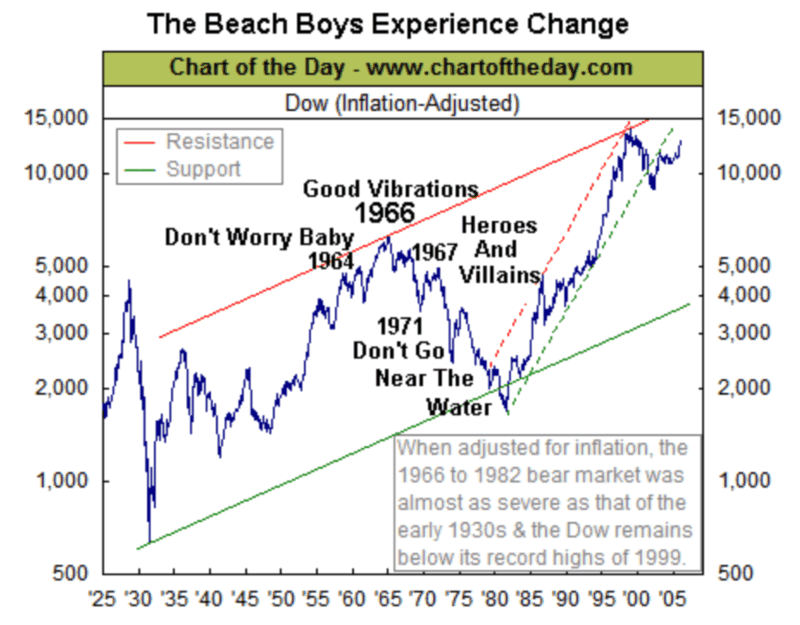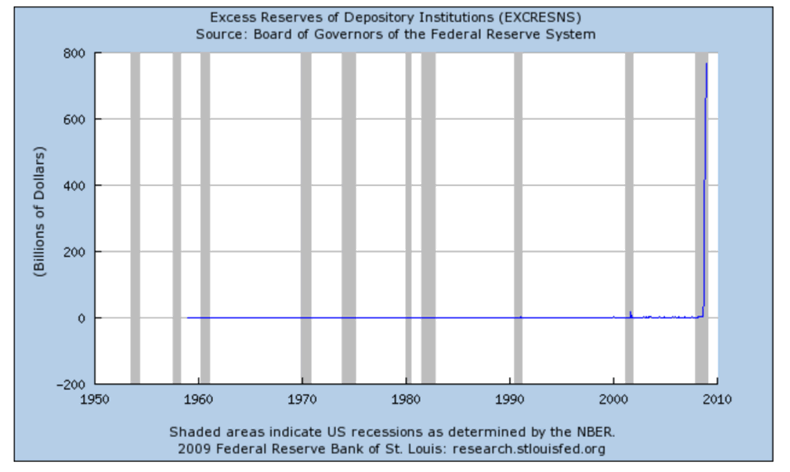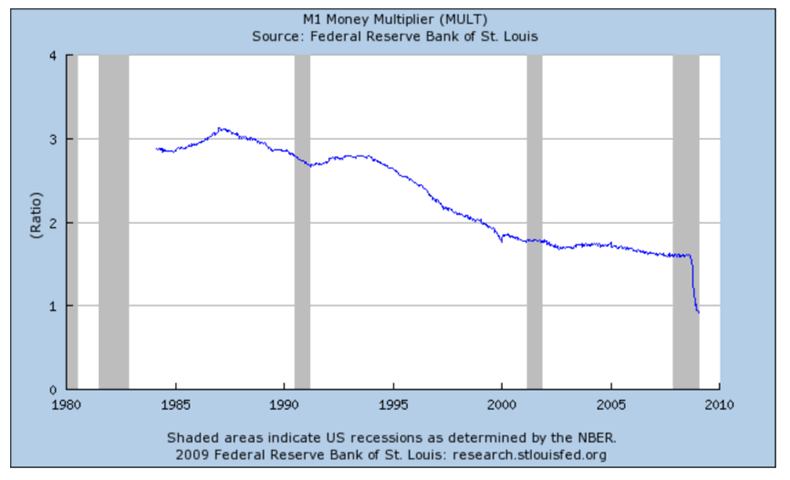The Money Printing Secret- Collapse in the Money Multiplier
Economics / Money Supply Feb 04, 2009 - 12:16 PM GMTBy: Paul_Lamont

 Heroes And Villains - In June of 1966 (similar to the warm sunny days of summer in 1929 and 2007 ), Brian Wilson produced the Beach Boys' single “Good Vibrations.” Capturing the positive feelings of the day, it quickly became a number one hit. But something had changed in 1967 when the Beach Boys moved on to their next album: Smile .
Heroes And Villains - In June of 1966 (similar to the warm sunny days of summer in 1929 and 2007 ), Brian Wilson produced the Beach Boys' single “Good Vibrations.” Capturing the positive feelings of the day, it quickly became a number one hit. But something had changed in 1967 when the Beach Boys moved on to their next album: Smile .
They just couldn't do it. With discord among the band members (Mike Love reportedly called Smile ‘acid alliteration'), Smile was simply shelved. Unable to deal with the pressure, Brian Wilson experienced an emotional meltdown. The next single released by the Beach Boys was titled “Heroes and Villains.”

Just compare the image of the Beach Boys of the early 60's to their appearance in the single “Don't Go Near the Water” produced in 1971 . The later single comes from the album Surf's Up . Oddly, the artwork of that album depicts the End of the Trail by James Earle Fraser. This kind of ragged exhaustion is laughable now, but remember we aren't down in the depths quite yet. Clearly the downward shift in social mood, as evidenced by the inflation adjusted Dow Jones Industrial Average (chart above updated to 2005), had made an impact.
“Consider what it means to live through our times in the light of (Ed Note: Austrian or Psychological) economic understanding. Even in the face of calamity, there is no mystery and hence fear is reduced…In many ways, it is like watching the movement of stars and planets with the scientific knowledge provided by astronomy, or observing the effects of a plague with medical knowledge…Without the understanding, the events look mysterious, like a curse from the gods, and their patterns appear random. With the knowledge, with the understanding, we can make sense of the events. Patterns of cause and effect emerge. You see events before they happen, like turning the page of a script before the movie catches up to you. This gives you a sense of intellectual coherence and inner peace – even in the midst of calamity.” - Lew Rockwell, Money and Our Future .
Surprise Losses
We would like to recommend to all of our readers Russell Napier's Anatomy of the Bear: Lessons From Wall Street's Four Great Bottoms . His analysis suggests we may have another 55% decline in the S&P by 2014 . How could that much more downside in the market be realized?
“There was some signs of economic stability in early 1931, but this resulted in only a modest rally in the equity market…Even at this stage, the magnitude of the decline in the index was only marginally in excess of the 1907 and the 1919-1921 bear markets. It was now that the second bank crisis hit. An investor committing funds to equities on Feb 24, 1931, almost 16 months after the October 1929 crash, would witness a 79% drop in the DJIA in the next 17 months. It was this period of decline that marked out the bear market as clearly different from anything before.” - Russell Napier, Anatomy of The Bear .
The banking crisis of 1931 (the second wave of Panic after 1929) was triggered by a surprise loss at an Austrian bank named the Creditanstalt. Earlier in the Panic, the Creditanstalt had been merged with a weaker bank:
“In 1929, the Bodenkreditanstalt (the ‘monarch of Austrian industry' according to Rudolf Notel, “Money, Banking and Industry in Interwar Austria and Hungary”) was fused overnight with the Creditanstalt. The Bodenkreditanstalt brought to the Creditanstalt large loans to industrial concerns which could be maintained only by the device of ignoring market values…When the Creditanstalt took over the Bodenkreditanstalt, it acquired 80 million shillings of capital. But it also acquired 140 million of accumulated losses, as it learned later when a British chartered accountant revealed the truth…the announcement of the support operation on May 11, 1931 started a run, partly foreign, partly Austrian.” - Charles Kindleberger, The World In Depression: 1929-1939.
Weaker banks have been rescued by stronger banks all over the globe. So far, Bank of America has already been surprised by losses from its Merrill Lynch merger . Others are sure to follow.
The Money Printing Secret – A Collapse in the Money Multiplier
The Fed is printing money as fast as it can and cramming it into the vaults of the banks. This ‘printed money' is known as the monetary base and includes Treasury Bills for bank reserves, currency, coins, etc. If we look at the broader measures of the money supply , we see that large portions of our money are actually private agreements created in the marketplace, such as deposits at banks, money market deposit accounts, and repurchase agreements. These private agreements are called commercial bank money. In a fractional reserve system, “ new commercial bank money is created through loans. ” We referred to these ‘money substitutes' in March of last year .
In a banking crisis, these additional private agreements are not necessarily entered into. Instead, fearful bankers pile up excess reserves (monetary base) and refuse to lend.

The money multiplier , the rate at which bankers take the Fed's printed money and multiply it into commercial bank money, collapses (chart below). This leads to a contraction in the money supply which is deflation.

Therefore, the Federal Reserve is unable to prevent a deflationary Depression because the amount of money base it prints becomes less and less effective in boosting the money supply. More Fed printing at this point will lead to more fearful hoarding by bankers and the two opposing sides are locked in to the deflationary spiral .
***More For Clients and Subscribers***
By Paul Lamont
www.LTAdvisors.net
At Lamont Trading Advisors, we provide wealth preservation strategies for our clients. For more information, contact us . Our monthly Investment Analysis Report requires a subscription fee of $40 a month. Current subscribers are allowed to freely distribute this report with proper attribution.
***No graph, chart, formula or other device offered can in and of itself be used to make trading decisions.
Copyright © 2009 Lamont Trading Advisors, Inc. Paul J. Lamont is President of Lamont Trading Advisors, Inc., a registered investment advisor in the State of Alabama . Persons in states outside of Alabama should be aware that we are relying on de minimis contact rules within their respective home state. For more information about our firm, or to receive a copy of our disclosure form ADV, please email us at advrequest@ltadvisors.net, or call (256) 850-4161.
Paul Lamont Archive |
© 2005-2022 http://www.MarketOracle.co.uk - The Market Oracle is a FREE Daily Financial Markets Analysis & Forecasting online publication.


